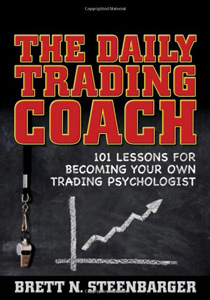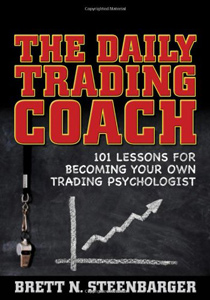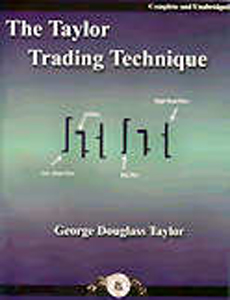The Daily Trading Coach
Praise for The Daily Trading Coach "A great book! Simply written, motivational with unique content that leads any trader, novice or experienced, along the path of self-coaching. This is by far Dr. Steenbarger's best book and a must-have addition to any trader's bookshelf. I'll certainly be recommending it to all my friends." Ray Barros CEO, Ray Barros Trading Group "Dr. Steenbarger has been helping traders help themselves for many years. Simply put, this book is a must-read for anyone who desires to achieve great success in the market." Charles E. Kirk The Kirk Report
"'Dr. Brett', as he is affectionately known by his blog readers, has assembled a practical guide to self coaching in this excellent book. The strategies he outlines are further enhanced with numerous resources and exercises for the reader to refer to and keep the principles fresh. I enthusiastically encourage anyone interested in bettering their trading and investing to read this book and keep it on their desk as a constant source of learning." Brian Shannon, author of Technical Analysis Using Multiple Time frames
"Dr. Brett has distilled his years of experience, as both a trader and a psychologist/coach, into the 101 practical lessons found in The Daily Trading Coach: 101 Lessons for Becoming Your Own Trading Psychologist Those lessons provide effective strategies for coping with the stumbling blocks that traders often face. This book should be a cornerstone of any serious trader's library." Michael Seneadza equities trader.
Positive Review of Book
This book is for traders who already have a trading plan or a strategy in discretionary trading. This book will show you methods how to stand by yourself, watch yourself, and help yourself to follow your own guidelines. Dr. Steenbarger states that he only coaches professional and institutional traders. So all of his books (I like Enhancing Trader Performance best) come at a huge discount. This book is divided into 10 chapters made off 101 lessons. The reader/trader may find that some lessons aren't of any concern to her, and then he finds other lessons that really address his specific need or problem. Dr Steenbarger's books even helped me in other areas of my life.
But as for trading; in my not so humble opinion, a proper trading plan is still the most important asset to the trader. By all means in trading one has to know why to do, when to do, and how to do something. It's like a traffic light: you may feel you're tired, sad, happy or excited; you still know what to do when you see green light or red light. Psychology takes care of itself after you've crossed the street. It's when your plan works and you find it's your own behavior that hinders to get the most off it, then this book might help you with overcoming your limitations.
Negative Review of Book
I read all the great reviews in here thinking this book must be really good. But upon reading it, I realized it's about training yourself to be a coach for yourself?? I thought this book was about learning how to beat the market by implementing trading strategies but it's all about stupid things like eating well, going to sleep early and bunch of other stupid mundane common sensical things that any average intelligent person should know. And what's learning to be a coach has to do with trading since trading in it self is already a handful to learn. The last thing I want is to add more unnecessary info into my already overwhelming trading strategies. Unless you have no common sense and you're less than an average intelligent person then buy this book but otherwise save your money for better books. And if you're that less than average then you shouldn't be trading the stock market to begin with. Once again I really don't know what other reviewers are seeing in this book that they gave 5 stars.
Edit:
Let me clarify again about what I said. Just why would I want to learn how to be a coach and instead of learning how to trade? It's like if you want to learn how to play tennis, why would you want to buy a book on how to be a tennis coach rather than learning how to play instead? I believe this author tries to be unique in trying to sell his book by being pretentious and somewhat condescending.
Author Biography
Brett N. Steenbarger, PhD, is Associate Professor of Psychiatry and Behavioral Sciences at SUNY Upstate Medical University in Syracuse, New York. An active trader and author of the popular Trader Feed blog, Steenbarger coaches traders in hedge funds, proprietary trading groups, and investment bank settings. He is also the author of the Wiley titles Enhancing Trader Performance and The Psychology of Trading. Steenbarger received a BS from Duke University and a PhD in clinical psychology from the University of Kansas.
Table of Contents
- CHAPTER 1 Change: The Process and the Practice.
- Lesson 1: Draw on Emotion to Become a Change Agent.
- Lesson 2: Psychological Visibility and Your Relationship with Your Trading Coach.
- Lesson 3: Make Friends with Your Weakness.
- Lesson 4: Change Your Environment, Change Yourself.
- Lesson 5: Transform Emotion by Trace-Formation.
- Lesson 6: Find the Right Mirrors.
- Lesson 7: Change Our Focus.
- Lesson 8: Create Scripts for Life Change.
- Lesson 9: How to Build Your Self-Confidence.
- Lesson 10: Five Best Practices for Effecting and Sustaining Change.
- CHAPTER 2 Stress and Distress: Creative Coping for Traders.
- Lesson 11: Understanding Stress.
- Lesson 12: Antidotes for Toxic Trading Assumptions.
- Lesson 13: What Causes the Distress That Interferes with Trading Decisions?
- Lesson 14: Keep a Psychological Journal.
- Lesson 15: Pressing: When You Try Too Hard to Make Money.
- Lesson 16: When You’re Ready to Hang It Up.
- Lesson 17: What to Do When Fear Takes Over.
- Lesson 18: Performance Anxiety: The Most Common Trading Problem.
- Lesson 19: Square Pegs and Round Holes.
- Lesson 20: Volatility of Markets and Volatility of Mood.
- CHAPTER 3 Psychological Well-Being: Enhancing Trading Experience.
- Lesson 21: The Importance of Feeling Good.
- Lesson 22: Build Your Happiness.
- Lesson 23: Get into the Zone.
- Lesson 24: Trade with Energy.
- Lesson 25: Intention and Greatness: Exercise the Brain through Play.
- Lesson 26: Cultivate the Quiet Mind.
- Lesson 27: Build Emotional Resilience.
- Lesson 28: Integrity and Doing the Right Thing.
- Lesson 29: Maximize Confidence and Stay with Your Trades.
- Lesson 30: Coping—Turn Stress into Well-Being.
- CHAPTER 4 Steps toward Self-Improvement: The Coaching Process.
- Lesson 31: Self-Monitor by Keeping a Trading Journal.
- Lesson 32: Recognize Your Patterns.
- Lesson 33: Establish Costs and Benefits to Patterns.
- Lesson 34: Set Effective Goals.
- Lesson 35: Build on Your Best: Maintain a Solution Focus.
- Lesson 36: Disrupt Old Problem Patterns.
- Lesson 37: Build Your Consistency by Becoming Rule-Governed.
- Lesson 38: Relapse and Repetition.
- Lesson 39: Create a Safe Environment for Change.
- Lesson 40: Use Imagery to Advance the Change Process.
- CHAPTER 5 Breaking Old Patterns: Psychodynamic Frameworks for Self-Coaching.
- Lesson 41: Psychodynamics: Escape the Gravity of Past Relationships.
- Lesson 42: Crystallize Our Repetitive Patterns.
- Lesson 43: Challenge Our Defenses.
- Lesson 44: Once Again, with Feeling: Get Distance from Your Problem Patterns.
- Lesson 45: Make the Most Out of Your Coaching Relationship.
- Lesson 46: Find Positive Trading Relationships.
- Lesson 47: Tolerate Discomfort.
- Lesson 48: Master Transference.
- Lesson 49: The Power of Discrepancy.
- Lesson 50: Working Through.
- CHAPTER 6 Remapping the Mind: Cognitive Approaches to Self-Coaching.
- Lesson 51: Schemas of the Mind.
- Lesson 52: Use Feeling to Understand Your Thinking.
- Lesson 53: Learn from Your Worst Trades.
- Lesson 54: Use a Journal to Restructure Our Thinking.
- Lesson 55: Disrupt Negative Thought Patterns.
- Lesson 56: Reframe Negative Thought Patterns.
- Lesson 57: Use Intensive Guided Imagery to Change Thought Patterns.
- Lesson 58: Challenge Negative Thought Patterns with the Cognitive Journal.
- Lesson 59: Conduct Cognitive Experiments to Create Change.
- Lesson 60: Build Positive Thinking.
- CHAPTER 7 Learning New Action Patterns: Behavioral Approaches to Self-Coaching.
- Lesson 61: Understand Your Contingencies.
- Lesson 62: Identify Subtle Contingencies.
- Lesson 63: Harness the Power of Social Learning.
- Lesson 64: Shape Your Trading Behaviors.
- Lesson 65: The Conditioning of Markets.
- Lesson 66: The Power of Incompatibility.
- Lesson 67: Build on Positive Associations.
- Lesson 68: Exposure: A Powerful and Flexible Behavioral Method.
- Lesson 69: Extend Exposure Work to Build Skills.
- Lesson 70: A Behavioral Framework for Dealing with Worry.
- CHAPTER 8 Coaching Your Trading Business.
- Lesson 71: The Importance of Startup Capital.
- Lesson 72: Plan Your Trading Business.
- Lesson 73: Diversify Your Trading Business.
- Lesson 74: Track Your Trading Results.
- Lesson 75: Advanced Scorekeeping for Your Trading Business.
- Lesson 76: Track the Correlations of Your Returns.
- Lesson 77: Calibrate Your Risk and Reward.
- Lesson 78: The Importance of Execution in Trading.
- Lesson 79: Think in Themes—Generating Good Trading Ideas.
- Lesson 80: Manage the Trade.
- CHAPTER 9 Lessons from Trading Professionals: Resources and Perspectives on Self-Coaching.
- Lesson 81: Leverage Core Competencies and Cultivate Creativity.
- Lesson 82: I Alone Am Responsible.
- Lesson 83: Cultivate Self-Awareness.
- Lesson 84: Mentor Yourself for Success.
- Lesson 85: Keep Detailed Records.
- Lesson 86: Learn to Be Fallible.
- Lesson 87: The Power of Research.
- Lesson 88: Attitudes and Goals, the Building Blocks of Success.
- Lesson 89: A View from the Trading Firms.
- Lesson 90: Use Data to Improve Trading Performance.
- CHAPTER 10 Looking for the Edge: Finding Historical Patterns in Markets.
- Lesson 91: Use Historical Patterns in Trading.
- Lesson 92: Frame Good Hypotheses with the Right Data.
- Lesson 93: Excel Basics.
- Lesson 94: Visualize Your Data.
- Lesson 95: Create Your Independent and Dependent Variables.
- Lesson 96: Conduct Your Historical Investigations.
- Lesson 97: Code the Data.
- Lesson 98: Examine Context.
- Lesson 99: Filter Data.
- Lesson 100: Make Use of Your Findings.
Discover more Trading books at BookofTrading.com!
- How to Trade Forex and Gold Options
- How to Trade the Gold Price and Profit!
- Forex Trading the EUR/USD Pair € EURO and $ US Dollar
- How to Trade Stock Market Indices S&P500
- How to Trade Crude Oil
- Forex Trading Psychology
- What Are Broker Recommendations?
- Free Tickets to Trading & Investing Seminar & Expo ($18) Brisbane 2013
- Stock Calc App
- All About Warrants
- Introduction to Exchange Traded Funds
- Introduction to Exchange Traded Funds: Features
- Introduction to Exchange Traded Funds: Domestic ETFs
- Introduction to Exchange Traded Funds: International ETFs
- Exchange Traded Commodities
- Australian Stock Scan
- Australian Online Share Trading
- List of Trading Books
- Interesting Thoughts about the Australian Dollar
- What's the Meaning of Hawkish?
- Do You Know How To Use the P/E Ratio
- Trading, Religion and Politics - Do They Have Anything in Common?
- Shares that are Volatile that Double and Half in the Short Term
- Telstra (TLS) T3
- Margin Call by E-mail
- The Cost of Holding a Position
- Lack of Disclosure: Compensation from ASX Listed Company
- Unrealistic Returns and Benchmarks
- CMC Markets Down
- Quality versus Quantity Forex Trading
- Woolworths 1H Sales $30.7bn up 3.2%
Date added 31-01-2013 - ASIC Fines CommBank's CommSec
Date added 25-09-2012 - Industry Super Network Calls to Ban High Frequency Trading (HFT)
Date added 22-09-2012 - NAB Launches Online Share Trading Platform
Date added 19-09-2012 - Reserve Bank of Australia Says 23 Countries Holding AUD
Date added 18-09-2012 - Australia Post Digital Mailbox
Date added 10-09-2012 - Winners and Losers of Trading for Week 2
Date added 16-01-2012 - 2012's First Week of the Best and Worst Traded Stocks
Date added 09-01-2012 - 2011's Last Best and Worst Traded Stocks
Date added 05-01-2012 - Best and Worst Pre-Christmas Traded Stocks
Date added 30-12-2011 - Trading Winners and Losers for Dec. 12-16
Date added 19-12-2011 - Best and Worst Traded Stocks for Dec. 5-9
Date added 13-12-2011 - Top 3 Best and Worst Traded Stocks
Date added 05-12-2011 - ASX Glitch Trading Halt
Date added 27-10-2011 - Worst Trade Stocks (and the Best)
Date added 06-08-2011
Top 150 Public Companies Listed on the Australian Stockmarket as at 29/05/2009
- BHP Billiton
- Westpac Banking Corporation (WBC)
- Commonwealth Bank of Australia (CBA)
- National Australia Bank (NAB)
- Telstra (TLS)
- ANZ
- News Corporation (NWS)
- Woolworths Limited(WOW)
- Woodside Petroleum Limited (WPL)
- Rio Tinto
- Westfield Group (WDC)
- Westfarmers Limited (WES)
- QBE Insurance
- CSL
- Newcrest Mining Limited (NCM)
- Origin Energy Limited (ORG)
- Santos Limited (STO)
- AMP Limited (AMP)
- Macquarie Group (MQG)
- Foster’s Group Limited (FGL)





